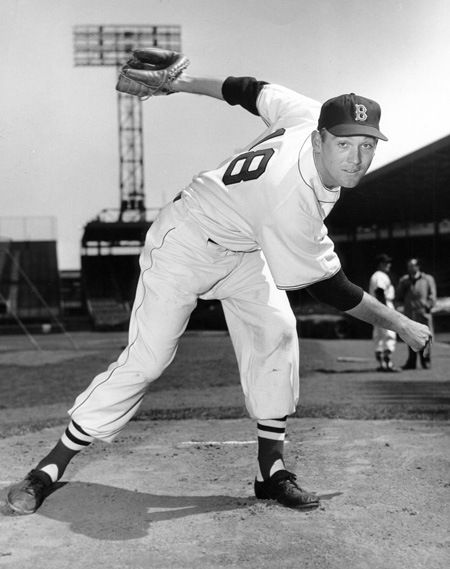 My dear friend Frank Sullivan would have been 94 years-old on January 23, 2024. And we miss his lovely wife Marilyn who passed away on January 15, 2020. It is still difficult to accept that we have lost both Frank and Marilyn but they left a wonderful legacy and much Aloha. And we have the birth of their great-grandson Wyatt Kaiea to celebrate! They had an extraordinary life and it is timely to revisit all that they experienced and achieved!
My dear friend Frank Sullivan would have been 94 years-old on January 23, 2024. And we miss his lovely wife Marilyn who passed away on January 15, 2020. It is still difficult to accept that we have lost both Frank and Marilyn but they left a wonderful legacy and much Aloha. And we have the birth of their great-grandson Wyatt Kaiea to celebrate! They had an extraordinary life and it is timely to revisit all that they experienced and achieved!
To say that my pal former Red Sox pitcher Frank Sullivan led an interesting life would be an understatement. He traveled the world, practiced with the Boston Celtics, graced the cover of The Saturday Evening Post, and played the Old Course at St. Andrews. Fifty-eight years ago, he moved to Kauai in the Hawaiian Islands with his great friend, former Red Sox catcher Sammy White. Frank had never set foot on Kauai before in his life and Sammy had only stopped by one day for an exhibition game!
And Frank had a very adventuresome career in the major leagues. His first full year in the majors was spent with a 1954 Boston Red Sox team that won only 69 games. The team had lost Hall of Fame left fielder Ted Williams when he separated his shoulder in the first hour of spring training. Sullivan earned his spot in the starting rotation when All-Star pitcher Mel Parnell had his wrist broken by a pitch thrown by former teammate Mickey McDermott. Frank achieved a very respectable 15-12 record for a Red Sox team that had a winning percentage of .448.
Frank had another excellent adventure with the 1961 Philadelphia Phillies. “I shudder whenever I think of that team,” Sullivan offered from his home in Liheu, Kauai. “We had lost 11 straight games and then we went out and won one. Right after that we lost 22 games in a row. That one win broke up an amazing losing streak.”
A STAR IS BORN
Franklin Leal Sullivan was born in Hollywood, California, on January 23, 1930, and grew up in nearby Burbank. “I grew up during the Depression, but my father always had a good job and he was always encouraging me to play sports. He had been a pretty good athlete and he wanted me to compete.
“I remember one time I got a job at a service station and he showed up there and said, ‘Go play ball.’ He didn’t want me working. I was a big kid, but I was coordinated, so I did well. Actually basketball was my first love then, and baseball was kind of filler.
“I had an offer of a basketball scholarship to Stanford, and I was leaning in that direction, but Red Sox scout Jack Corbett saw me pitch and he wanted to sign me. Jack saw me pitching American Legion ball, but there was another left-handed pitcher named Frank Sullivan, and I think he showed up thinking he would see him. I went to Boston with Jack to talk about signing a contract.”
Sullivan still remembers that fateful trip to Boston. “We flew to Boston for a tryout at Fenway Park. We were staying at the Somerset Hotel in Kenmore Square, and we ran into Red Sox pitchers Mickey McDermott and Chuck Stobbs. They invited me to join them. I took my first cab ride ever, to downtown Boston, and I followed Mickey into the Arrow shirt store. Mickey bought a dozen new shirts, put one of them on, and left the one he was wearing in the store. That’s when I made the decision to sign a pro baseball contract if it was offered.”
CLASS A BALL TO THE MAJORS
Sullivan’s early days in the minor league were painful. “I didn’t have a lot of success, and to tell you the truth, I was homesick. I had to do some growing up fast.”
His nascent professional baseball career was interrupted by two years of service with the Army in the Korean War. During his tour of duty he spent four and one-half months on the front line in combat. It was an experience that made a lasting impression on him. He was awarded a Combat Infantry Badge and was honorably discharged as a Staff Sergeant in 1952.
“I didn’t really become a pitcher until 1953, when I was with the Red Sox farm club in Albany, New York, in Class A ball. That was also the year I discovered I wasn’t considered a prospect. I had experienced a little arm trouble and I went to our manager, Jack Burns, to tell him I was fine and that I wanted to pitch. He said, ‘I know you’re fine, and I want to get you in there, but the Red Sox told me I have to pitch the prospects.’ But he did work me in and I pitched pretty well.
“It was around that time that my catcher Len Okrie came out to the mound and said, ‘Stop worrying about what you are doing out here, and start worrying about what is happening at home plate.’ It was as if a light went on for me. From that point on I was a different pitcher.
“Later that season Jack Burns was in Boston attending a meeting at Fenway Park. Red Sox manager Lou Boudreau said, ‘Don’t we have anyone in our organization who can throw strikes?’ Jack said, ‘I’ve got a guy who can throw strikes.’ And I was on my way to Boston.”
THE BOSTON SKYSCRAPER
Baseball writers often referred to Frank Sullivan as the “Boston Skyscraper,” because at 6’7” he was one of the tallest pitchers in major league history. “My father was 6’0” and my mother was 5’5”, but I was always tall. I found it to be a big advantage as a pitcher, especially coming in sidearm the way I usually did.”
Sullivan made his debut on July 31, 1953, and pitched well in 14 relief appearances. “The best thing for a pitcher is to come up as an unknown. I had made the jump all the way from “A ball” so the hitters didn’t know anything about me. And I could throw my slider for strikes. They would be looking for a fastball and I would come in with a slider for my out pitch.”
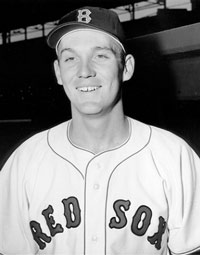 Frank started the 1954 season in the bullpen for the Red Sox, but in mid-April, a teammate’s misfortune created a spot for Sullivan in the starting rotation. The Red Sox had traded pitcher Mickey McDermott to the Washington Senators in the off-season, and his errant pitch broke Red Sox pitching ace Mel Parnell’s left wrist. The 24-year-old Sullivan took advantage of this opportunity, putting together 15 wins, tops among Red Sox pitchers.
Frank started the 1954 season in the bullpen for the Red Sox, but in mid-April, a teammate’s misfortune created a spot for Sullivan in the starting rotation. The Red Sox had traded pitcher Mickey McDermott to the Washington Senators in the off-season, and his errant pitch broke Red Sox pitching ace Mel Parnell’s left wrist. The 24-year-old Sullivan took advantage of this opportunity, putting together 15 wins, tops among Red Sox pitchers.
Sullivan pitched well at the beginning of the following season, and his strong start earned him a spot on the 1955 American League All-Star team. The American League jumped out to an early lead in the first All-Star Game played in Milwaukee, but Sullivan was called in to squelch a National League rally in the eighth inning. “When I was walking in from the bullpen in center field, Mickey Mantle said, ‘Sully, you better shut them down or we’re going to miss the cocktail hour.’ I was too nervous to reply. I got the first batter to hit a ground ball but Al Rosen booted it, and they tied the score.
“I got out of the inning and then I shut them down in the ninth, the tenth and eleventh. I was pitching to guys like Musial, Mays, and Aaron, but I managed to hold them. Then Musial comes up for the second time and hits a ball into the right field stands. My catcher, Yogi Berra, comes up to me later in the locker room and says, ‘I should have told you he was a high fastball hitter.’”
Frank continued his winning ways in the second half of the season, and the Red Sox nipped at the Yankees’ heels in the American League pennant race before running out of gas in mid-September. He led the American League in games started, innings pitched, and his earned run average of 2.91 was fifth in the league. His 18 wins tied for the American League lead and led the Red Sox staff for the second year in a row.
Like most pitchers before the era of the designated hitter, Frank Sullivan enjoys talking about his hitting prowess. In Frank’s case, his favorite hitting memory is his triple in 1955. “The ball hit the top of the left field wall and bounced away. And I think the left fielder fell down. I went sliding into third base and they almost threw me out. After I dusted myself off, our third base coach, Jack Burns, shook my hand and said, ‘I want to introduce myself. I’m the third base coach. You haven’t spent a lot of time here.’”
FRANK AND SAM
Frank Sullivan is quick to share credit for his pitching success with his battery mate and long-time friend, Sammy White. “Sam was my first roommate with the Red Sox and we hit it off right away. He was my close friend for almost 40 years and I never had a bad moment with Sam.
“We were so attuned that Sam would only give me signs for the first three innings of a game. By then we would have established our pattern and he didn’t have to give me a sign. He knew what was coming and I knew he would be ready for the pitch I would throw. It was almost uncanny.”
In 1956, Frank Sullivan compiled a career best winning percentage of .667, which ranked seventh in the American League and first for the Red Sox. He also was named to the American League All-Star team for the second season in a row.
On an off day in 1956, Sullivan, Sam White, and Jackie Jensen were told to drive to Stockbridge, Massachusetts, and to bring their uniforms. “When we got there we were greeted warmly by a small, slim man, whose name meant nothing to me. He posed us and took a number of pictures, explaining that the background would be the locker room we used in Sarasota, Florida, for spring training. I remember ragging on Jackie Jensen on the way back, saying the trip was all his idea, and the photographer didn’t seem to know what he was doing.
“The following March, I pick up The Saturday Evening Post, and there we were on the cover. The man was an illustrator, not a photographer, and if you look closely, you’ll see we are wearing street shoes, not spikes. The cover was titled ‘The Rookie’ and the man’s name turned out to be Norman Rockwell.”
 The 1956 Red Sox finished fourth in the American League for the fourth straight year. Frank Sullivan’s earned run average of 3.42, and his 33 pitching starts led the Red Sox pitching staff. His 14 victories were second to teammate Tommy Brewer’s 19 wins.
The 1956 Red Sox finished fourth in the American League for the fourth straight year. Frank Sullivan’s earned run average of 3.42, and his 33 pitching starts led the Red Sox pitching staff. His 14 victories were second to teammate Tommy Brewer’s 19 wins.
The break following the 1956 season is one of Frank’s favorite memories. “In the past, I had always gone home to California to work or gone to Mexico to pitch winter ball. Sam convinced me to stick around and make personal appearances around New England. We were so in synch that we developed a pretty good presentation and I think we were making more than we did playing ball.
“This one time we were booked to speak way up in Presque Isle, Maine. We get there and they have us scheduled in a very large auditorium, before a huge audience. We were on between a tap dancer and a banjo player. I was a little overwhelmed since we usually appeared in a more intimate setting, but Sam assured me he would take care of everything.
“He stood before the microphone and announced, ‘Ladies and gentlemen, my name is Sam White and I am a catcher for the Boston Red Sox. Normally I would be here to talk to you about baseball, but not tonight. Tonight I am here to introduce the funniest man I know. In fact, he is so entertaining that I am coming down to sit with you.’ And with that, he left the stage. Fortunately winter in Presque Isle is pretty boring. Nobody threw anything.”
RENAISSANCE MAN
Frank also made a significant contribution to a Boston sports team during this eventful off-season. “It was the season that Bill Russell joined the Celtics, and Jack Nichols was the other center. He was finishing up dental school and he told Red Auerbach that he could play in the games but he didn’t have time to practice. Nichols had played college basketball with Sam White, and Jack asked me if I would replace him in practice.
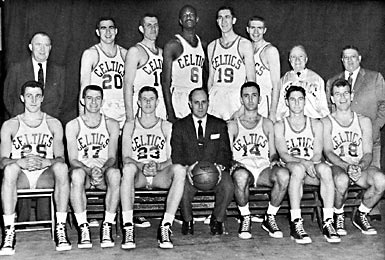
“I said I would, and two things happened every practice. Every time I was chosen to be on one team for a scrimmage, the other team clapped, and I would end up trying to guard Tom Heinsohn, who was rookie of the year that season. Auerbach used me all pre-season and asked me to think about playing two sports, but I told him I was already maxed.”
The 1957 Red Sox improved to third place in the American League, trailing the pennant-winning Yankees and the second place Chicago White Sox. Apparently Frank Sullivan’s winter training with the Celtics was offset by his time on the banquet circuit, as his personal win total held at 14. That win total ranked seventh in the American League, and his complete game total of 14 ranked fourth.
It was in this time period that Sullivan became a sailor. “I bought a 38’ ketch rigged sailboat in Westerly, Rhode Island. Somehow I managed to sail it back to Winthrop. Looking back on it, it probably would have been good to take a lesson or read a book. I decided to sail down to spring training before the next season. I wish I could say I sailed down, but the truth is, we kind of bumped our way south.
“I finally made it to the Florida Keys, not without incident, and I docked at the marina in Islamorada. I called my teammate, Ted Williams, who came down to pick me up. We had a lot of laughs as I related my trip down. He had predicted that I would never make it.
“I spent one day helping Ted with a carpentry project and learned that the greatest hitter in baseball history didn’t own a tape measure. He picked me up the next morning with a boat in tow when it was still pitch-black. The sun was just rising as we reached the launch ramp, and I jumped out of the car looking to buy a case of beer. The next thing I knew he had the boat in the water and he was hollering, ‘Get over here, “Bush,” or I’m fishing alone.’
“We fished all day and his concentration was unreal. All we had with us was an apple apiece and some water. Ted worked every minute we were out there and I have never been more exhausted after a day of fishing. But just think, I spent eight years watching the best hitter and even got to fish with the best fisherman.”
The 1958 Red Sox finished third again, and Ted Williams won his sixth American League batting title, edging out teammate Pete Runnels for the honor. Frank Sullivan continued his consistent pitching ways with thirteen wins. It was his fifth straight season of double-digit win totals for the Red Sox.
After the 1958 season, Sullivan agreed to deliver a 42-foot Chris Craft powerboat to Fort Lauderdale, Florida, for George Page, who owned the Colonial Country Club in Lynnfield. He selected Sam White as his crew. White was selected more for his pleasant company than for his seamanship.
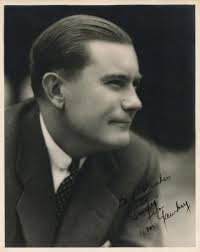
“I was told that Red Sox owner Tom Yawkey owned an island off the South Carolina coast. The closer we got to South Carolina, the better the idea of stopping by to say hello to Mr. Yawkey sounded. I located Cat Island, and after a quick stop we called and we were graciously invited for a visit. We were met at a long pier by two World War II Jeeps and we were driven to the main complex. Mr. Yawkey personally showed us his private game preserve. They treated us to a great dinner and we all had many laughs. The evening came to an end shortly after Mr. Yawkey gave Sam some hitting advice, using a broom as a bat.”
WINDING DOWN
The big change for the Red Sox in 1959 was a shift in their spring training headquarters. The team had trained in Sarasota, Florida, since 1933, but in 1959, spring training was shifted to Scottsdale, Arizona. “I hated training in Arizona,” Sullivan recalls. “You couldn’t raise a sweat, you couldn’t get loose. And there was nothing to do in Scottsdale.
“I was pitching against the Cubs in Mesa, Arizona, and the mound was terrible. I just couldn’t get comfortable. I felt a tweak in my back and I knew I was in trouble. I felt back spasms all the way back to Scottsdale. Then we broke camp, and flew to New York to open the season. It was raining there, but I wanted to get my running in. The next thing I knew I was very sick and I was diagnosed with pneumonia. They sent me back to Boston by train, and I stayed in Sancta Maria Hospital in Cambridge until I recovered.”
Frank Sullivan never did get on track during the 1959 season. He ended up with a record of 9-11 for his first losing season in seven years in the major leagues. The following season was worse, as his record fell to 6-16. On December 15, 1960, he was traded to the Philadelphia Phillies for 6’9” pitcher Gene Conley.
“The Red Sox sent me a telegram, ‘You have been traded to the Phillies, good luck.’ I remember saying to the telephone operator who read it to me, ‘Honest?’ I was destroyed. I talked to George Page, whom I considered my second father, and he advised me to tell the Phillies that I wasn’t sure I wanted to play any more because I could make more money working for George.
“When Gene Mauch, who managed the Phillies called that evening, I told him I was going to call it quits and stick with my off season job. He said, ‘How much do you need, Sully?’ That’s when I realized I wasn’t prepared with an answer, and I told him $25,000. He replied, ‘That’s easy, Sully. You got it.’ Now you now why most players have agents.”
The 1961 season would turn out to be Frank Sullivan’s worst in the major leagues. He won 3 games and lost 16, playing for a Phillies team that lost 107 ballgames in a 154 game season. “We were terrible,” Sullivan recalls. “Our best hitter batted .277. I was awful, but Robin Roberts was 1-10, and he’s in the Hall of Fame.”
After starting the 1962 season with a 0-2 record, he was released by the Phillies and signed immediately by the Minnesota Twins. “I got to play for my great friend Sam Mele, who had been a teammate on the Red Sox. He was one of the best managers I ever had.”
Sullivan rebounded nicely for the Twins, going 4-1 in 20 appearances during the balance of the 1962 season. But on June 19, 1963, the Twins released him. After eleven seasons in the major leagues, his professional baseball career was over.
“It’s a big adjustment for a player when his career ends. All those years, for seven months each season, you walk into the clubhouse and there’s a fresh uniform waiting for you. And then, just like that, it’s over.”
CHANGES IN ATTITUDES, CHANGES IN LATITUDES
“I did a number of different things over the next year or so. Then one day Sam White said, ‘We ought to go someplace totally different and start over.’ That appealed to me, and an island seemed to make sense to both of us. We thought a little bit about the Caribbean, but that didn’t feel right. Finally, we settled on Kauai in the Hawaiian Islands.”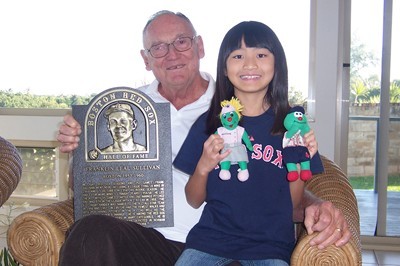
Kauai is the oldest and northernmost of the main Hawaiian Islands. It is about a 20-minute flight from Honolulu. It is 550 square miles with a permanent population of a little over 50,000. It is also Frank Sullivan’s vision of paradise.
“Sam and I had never been here, but we got a job with a helicopter company right away working construction. We built landing pads at different locations throughout the island. I had no idea what a hard worker Sam was. He would stick a cigar in his mouth and work all day.”
Asked if there were many Red Sox fans on Kauai, Frank laughs heartily. “Shortly after we got here, Sam and I put on a clinic for a bunch of Little Leaguers. I was throwing to Sam behind the plate, and we were really humming. When I walked off the field, this little kid said, ‘Who do you play for?’ I said proudly, ‘I played for the Red Sox.’ He looked me over and replied, ‘So do I.’ I knew at that moment that I was a long way from Boston. It was very humbling.
“My wife to be, Marilyn, joined us after about three months and she got a job as an executive secretary at the Kauai Surf Hotel. After a year of working construction, I took over the beach concession for the Kauai Surf. A couple of years later, I became the assistant golf pro there, and eventually I became the head pro.
“In 1978, Sam and I got certified by the PGA, and I’ve been the Director of Golf for a number of courses here over the years. I’ve been a golf consultant to the Grove Farm Company for almost ten years now.”
Sadly, Sam White passed away on Kauai in 1991. “Sam was my close friend for almost forty years. I enjoyed every minute I spent with him. He was like a brother to me.”
Frank looks back fondly on his years in Boston. “Those were wonderful years. I loved that city and the fans were great. I got to play for eight years with Ted Williams, and watch the greatest hitter ply his craft. He could tell you if he hit one seam, or two seams, of a ball that was coming at him at 100 miles per hour.”
He always enjoyed watching the games that are televised in Kauai, but gets mildly annoyed with the color commentators. “I’m amazed when I hear commentators like Tim McCarver and Joe Morgan telling the viewers exactly what is going through the minds of the players. I can remember standing on the mound at Fenway and thinking, ‘Damn, this is a nice day! What could be better? Here I am facing Mickey Mantle and he’s smiling at me.’ Of course I found out later that Mickey, and a bunch of his teammates, had spotted my VW Beetle behind the Kenmore Hotel, lifted it up on the sidewalk, and deposited it behind a telephone pole next to a brick wall. But there was no way that any announcer could have guessed what I was thinking.”
Frank and his wife Marilyn were married for almost 50 years and they have a son, Mike, a grown granddaughter, Kea, and a grandson Pono who shows great promise on the baseball diamond!. Frank’s son from his first marriage, Mark, lives in Maggie Valley, North Carolina, and he has three children, Summer, Lauren, and Kevin.
THE PEN OF A POET AND THE HEART OF A ROSE
Frank has been writing down his memories of baseball and his interesting life for a number of years. “When my father was 86 years old, I asked him to tell us some stories about what it was like for him growing up. He told us stories that I had never heard before for over three hours. I learned that he had been a very good athlete, that he had a number of fascinating experiences, and I learned that my great, great grandfather had been the sheriff of Virginia City. It motivated me to start writing things down.”
The following is an excerpt from a tribute that Frank wrote upon the death of former teammate Willard Nixon, who pitched for the Red Sox from 1950 to 1958:
“We leave the dock at 6:30 AM on this Sunday, December 10, 2000, which is the same time we have been leaving it for 20 years in one boat or another. As usual, I am busy helping out with the different chores required for departure. As we leave the harbor still in the dark, I can feel the heave of the boat, and here on Kauai, the moment you leave the harbor you can get a real read on what the day will be like. When we push out past the headlands, it is obvious that we are going to be treated to an incredible sunrise.
I can’t help reflecting that this sun that is rising so beautifully for me has just set on the life of my friend and teammate, Willard Nixon. I go down to the back deck and sit on one of the fish boxes alone and I don’t deny crying. Here I am watching one of the most glorious sunrises while alive and healthy, and Willard’s luck has just run out.
My day remained glorious and we caught plenty of tuna, but I found it hard fishing with tears in my eyes.”
Frank Sullivan started 201 games for the Boston Red Sox and he completed 72 of those starts. But in this case, we are going to use him as the closer.
“Simply put, I’ve had a hell of a good life. I’ve seen Niagara Falls bathed in floodlights and been to the Rock Islands of Palau. Watched the sunset in the lee of Niihau and pitched in a major league All-Star Game.
I sat in the company of Joe DiMaggio to hear Sinatra sing with the Tommy Dorsey Band at the Palladium and drank with Ralph Evenrude on his yacht. Been to the rain gauge at the wettest spot on earth and watched Ted Williams hit his last home run in his last at-bat in Fenway Park.
I’ve been to Hatchet Bay, Eleuthra, and taken the tube in London. Attended the Masters Golf Tournament in Augusta and flown to Kwajalein. Seen the Rock of Gibraltar and had my picture taken with Ed Sullivan. My hometown honored me with a parade and I got paid to play ball in Mexico.
With all of that said, the best thing I ever did was marry the girl with whom I live.”
Frank Sullivan could write as well as he pitched. And as the record shows, he was a very fine pitcher.


great article and thank you for printing this. our very dear friends of ours. together again.
Beautiful tribute to a wonderful man.
Loved reading this article. What a cool story he has to tell and you did it superbly. RIp Mr. Sullivan. Would have loved to have met and watched you pitch.
Just a great article Herb. I never tire reading about Frank. Such a fun and interesting person.
The term-One-of-a-kind-is overused but in Franks case it was true!!